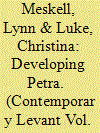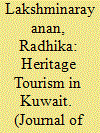| Srl | Item |
| 1 |
ID:
183190


|
|
|
|
|
| Summary/Abstract |
This article charts the nascent development agendas for archaeological heritage and tourism at Petra in Jordan. We begin with the early internationalism of UNESCO and its participation programme for Petra followed by the restructuring of American foreign policy interests to embed heritage tourism within USAID projects. A technocratic tourism-as-assistance model galvanised USAID and the World Bank’s interest in Petra, as it did the CIA, the American Schools of Oriental Research, the US National Park Service, and Jordan’s Department of Antiquities. Thus, we reveal how saving Petra was underwritten by an increasing American vigilance in the Middle East. Unlike the educational and humanitarian components of the United Nations programme, the USAID and World Bank initiatives at Petra were almost exclusively directed toward tourism development, generating hard-currency revenue, monetising the Nabataean ruins, and sowing the seeds of predatory capitalism. Our longitudinal study reveals that what has been sustained at Petra is not the preservation of heritage, nor support for local communities, but rather an overburden of international bureaucracy and consultancy culture.
|
|
|
|
|
|
|
|
|
|
|
|
|
|
|
|
| 2 |
ID:
169447


|
|
|
|
|
| Summary/Abstract |
Recent volatility in oil markets and the economic constraints of a budget deficit are compelling “rentier” states like Kuwait to seek various avenues for economic diversification. This article suggests that promoting heritage tourism could potentially transform the economy and propel tourism growth overall. It seeks to identify the prospects for heritage tourism development through an exploration of the tangible and intangible heritage of Kuwait. The paper provides an insight into challenges and constraints facing heritage tourism development in Kuwait including the need for training, education, image branding and marketing. Finally it suggests a framework for sustainable heritage tourism. Primary data was collected through field work in heritage institutions and museums and informal interviews with staff and visitors, and complemented by institutional brochures, official websites, newspaper reports, tourist information and government databases.
|
|
|
|
|
|
|
|
|
|
|
|
|
|
|
|